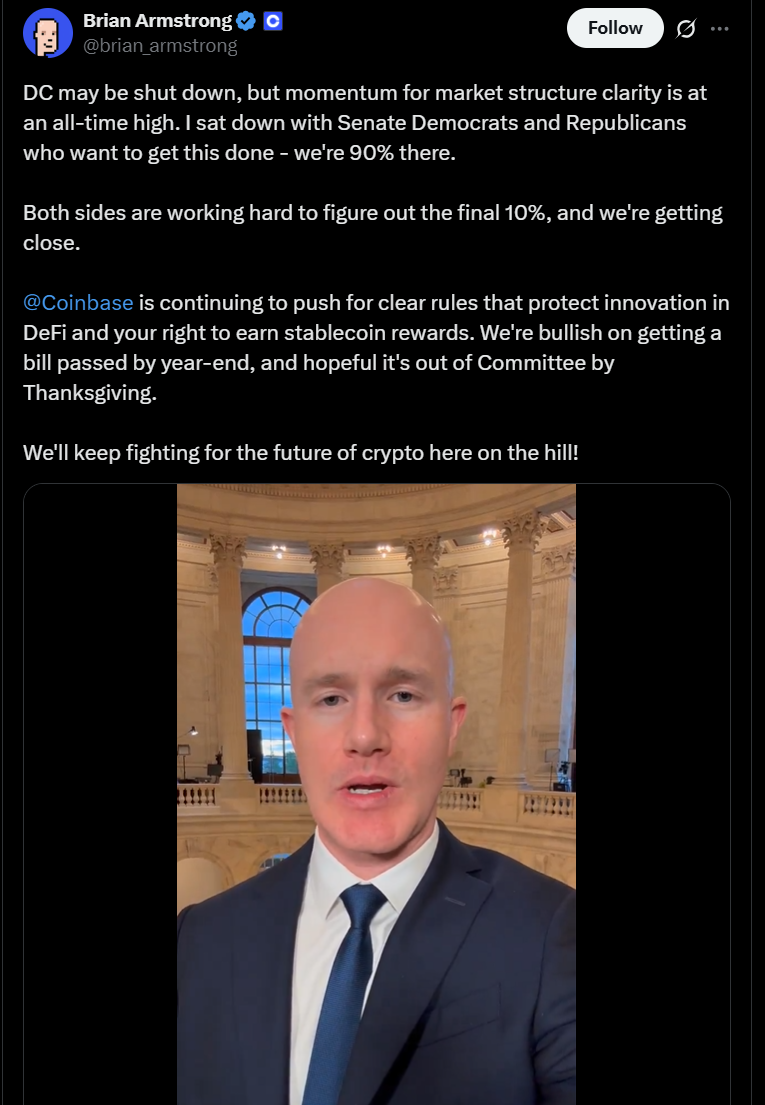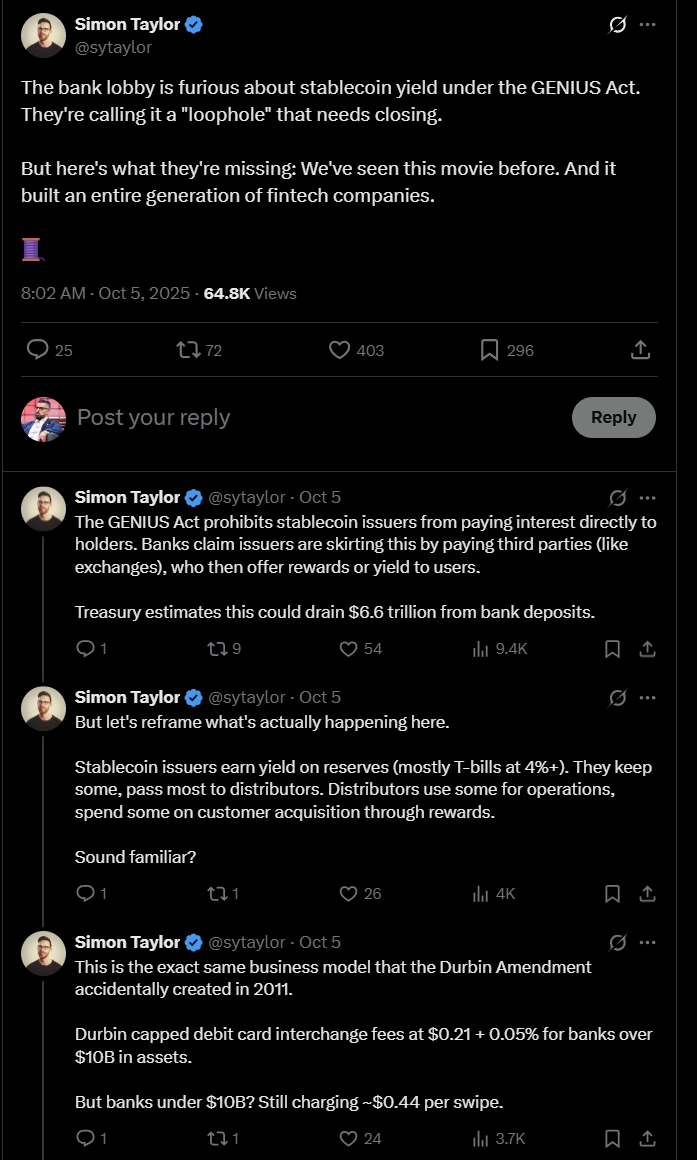US crypto market structure legislation is advancing rapidly, with Coinbase CEO Brian Armstrong noting 90% agreement among senators, focusing remaining issues on DeFi while protecting innovation. Lawmakers aim to regulate centralized entities without stifling protocols, amid optimism for passage by Thanksgiving despite government shutdown.
-
Senators have reached consensus on 90% of the crypto market structure bill, leaving DeFi aspects for careful review.
-
Brian Armstrong highlights bipartisan support, emphasizing regulation of centralized intermediaries like exchanges over open protocols.
-
The GENIUS Act has established stablecoin standards, but faces banking lobby opposition over potential yield loopholes for holders, with data showing over 80% of industry experts optimistic on progress.
Discover the latest on US crypto market structure legislation as Coinbase’s Brian Armstrong predicts swift Senate approval. Explore DeFi safeguards, stablecoin protections, and banking pushback. Stay informed on crypto’s regulatory future—read more now!
What is the current status of US crypto market structure legislation?
US crypto market structure legislation is progressing toward potential approval by Thanksgiving, according to Coinbase CEO Brian Armstrong. He expressed optimism in a recent video update, stating that despite the government shutdown, Senate efforts continue unabated with broad bipartisan agreement. Roughly 90% of the framework has been settled, centering the final 10% on decentralized finance (DeFi) to balance innovation and oversight.

Source: Brian Armstrong
Armstrong’s comments reflect a shifting landscape in Washington, where regulators and lawmakers are increasingly aligning on the need for clear rules to foster cryptocurrency growth. This legislation aims to define market structures, ensuring consumer protections while enabling the sector’s expansion. Experts from institutions like the Brookings Institution have noted similar trends, with internal memos indicating accelerated negotiations.
How does the GENIUS Act impact stablecoins in crypto regulation?
The GENIUS Act, enacted earlier this year, establishes federal guidelines for stablecoin reserves, transparency, and consumer safeguards, marking a pivotal step in US crypto market structure legislation. It prohibits stablecoin issuers from directly offering interest or yields, yet this does not extend to exchanges, creating what some critics call an indirect pathway for holder rewards. According to analysis from the Bank Policy Institute, this exclusion could undermine the act’s intent by allowing evasion of restrictions, potentially shifting economic incentives away from traditional banking.

Source: Simon Taylor
Armstrong warned of banking sector resistance, describing it as a “cash grab” attempt to revisit the act’s provisions. “The big banks are coming for their cash grab, trying to block that. We’re not going to let them re-litigate that,” he stated. Industry observers, including New York University professor Austin Campbell, have observed bankers’ concerns over stablecoins disrupting low-interest deposit models, with projections from Deloitte estimating stablecoin market capitalization could reach $500 billion by 2026 if yields are preserved. This tension underscores the broader debate: protecting innovation versus maintaining financial stability. Policymakers are threading this needle by targeting centralized intermediaries for regulation, sparing underlying protocols to encourage DeFi development. Data from the Federal Reserve highlights that stablecoins now represent over 10% of cross-border payments, amplifying the stakes for comprehensive rules.
Further, the act’s passage has spurred discussions on real-world asset (RWA) tokenization, with executives from platforms like Aptos anticipating a boom as clearer standards reduce entry barriers. Circle, a leading stablecoin issuer, has emphasized that the GENIUS Act prevents dominance by big tech or banks, promoting a diverse ecosystem. These developments align with Armstrong’s vision, where 90% consensus on the bill ensures regulated entities like Coinbase operate under defined parameters without hampering decentralized innovation.
The focus on DeFi in the remaining legislative hurdles involves crafting measures that safeguard users from risks like smart contract vulnerabilities, which affected $1.7 billion in exploits last year per Chainalysis reports. Lawmakers are consulting with blockchain experts to implement oversight that preserves the permissionless nature of protocols. This approach draws from global precedents, such as the EU’s MiCA framework, adapted to U.S. priorities on anti-money laundering and investor protection.
Bipartisan support has been bolstered by recent Senate hearings, where figures from both parties endorsed the need for market structure clarity to compete with international hubs like Singapore. Armstrong’s update on X (formerly Twitter) garnered widespread attention, with over 50,000 views in hours, signaling strong community interest. As negotiations intensify, the emphasis remains on stablecoin rewards, with advocates arguing they incentivize adoption without systemic risks, backed by studies from the IMF showing stablecoins’ role in financial inclusion for unbanked populations.
Banking lobbies, represented by groups like the Bank Policy Institute, continue to voice opposition, citing potential evasion of interest prohibitions as a threat to deposit bases holding $18 trillion in assets. Their statements highlight fears of capital flight, yet proponents counter that regulated yields could integrate crypto more seamlessly into mainstream finance. This ongoing dialogue exemplifies the careful calibration in the 10% of unresolved issues, ensuring the final bill supports a vibrant, secure crypto economy.
Frequently Asked Questions
What progress has been made on the US crypto market structure legislation?
The US crypto market structure legislation has achieved 90% agreement among senators, as stated by Coinbase CEO Brian Armstrong. Focus remains on DeFi regulations to protect innovation, with bipartisan efforts pushing for passage by Thanksgiving despite the shutdown. This framework targets centralized entities for oversight, leaving protocols largely untouched.
How is the GENIUS Act addressing stablecoin yields and banking concerns?
The GENIUS Act sets standards for stablecoin reserves and transparency, banning direct interest from issuers but allowing exchanges to offer yields indirectly. This has raised banking lobby alarms over business model threats, yet experts like Austin Campbell note it promotes competition. Overall, it balances innovation with protections, spoken naturally for voice searches on crypto rules.
Key Takeaways
- Bipartisan Consensus on 90% of Bill: Senate negotiations show strong agreement, prioritizing DeFi without overregulating open protocols.
- GENIUS Act’s Stablecoin Safeguards: Establishes federal standards while facing pushback from banks concerned about yield loopholes and deposit shifts.
- Optimism for Swift Passage: Brian Armstrong urges protection of stablecoin rewards to foster innovation—monitor Senate updates for investment strategies.
Conclusion
In summary, US crypto market structure legislation nears a milestone with 90% consensus, as highlighted by Coinbase CEO Brian Armstrong, while the GENIUS Act fortifies stablecoin frameworks amid banking opposition. This progress signals a maturing regulatory environment that balances oversight on centralized players with DeFi innovation. Looking ahead, stakeholders should prepare for implementation, positioning crypto as a cornerstone of the global financial system—engage with evolving policies to capitalize on emerging opportunities.





